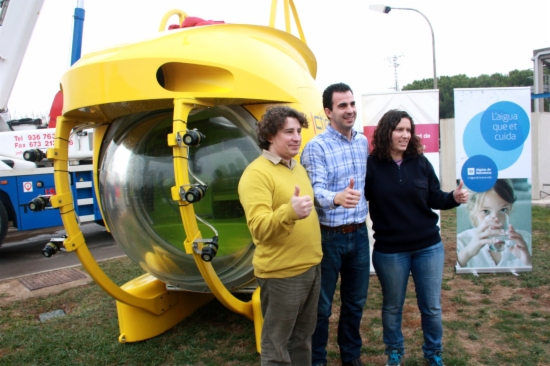First dive for Catalan submarine ICTINEU 3 built through crowd-funding
ICTINEU 3, a scientific submersible designed and build in Catalonia, has entered the water for the very first time in a test dive near Barcelona. For over ten years, particular donations have helped construct this submarine that will be dedicated to “underwater exploration, scientific research and underwater intervention”. This first test was used to verify that all of the submarine’s systems could function underwater, and the next step will be a dive in seawater. ICTINEU 3 was named after the very first air independent and combustion engine driven submarine, ICTINEU 1, which was invented by Figueres’ engineer Narcís Monturiol and dived for the first time in the Catalan capital’s harbour.

Sant Feliu de Llobregat (ACN).- ICTINEU 3, a scientific submarine designed and build in Catalonia, has entered the water for the very first time in a test dive. It has partially been founded through crowd-funding and it honours Catalan engineer Narcís Monturiol, the inventor of the first entirely independent submarine. For over ten years, particular donations have helped construct this submarine, whose total cost reached €2.5 million. It will be dedicated to “underwater exploration, scientific research and underwater intervention”. This first navigation test, which took place in Sant Feliu de Llobregat’s water plant (Greater Barcelona), was used to verify that all of the submarine’s navigation systems could function underwater, and the next step will be a dive in seawater in January. ICTINEU 3 was named after the very first air independent and combustion engine driven submarine, ICTINEU 1, which was invented by Figueres’ Narcís Monturiol in 1859. ICTINEU 3 can travel as deep as 1,200 metres, has a 10 hour-autonomy and can carry 3 people. Once the device gets all the certifications needed, the people responsible for the project will have to “look for work”, attracting companies and research institutions. The Operations Director of Ictineu Submarines, Carmen Parareda explained they wished the submarine to be used in a scientific manner, by researchers, archaeologists and oceanographers. The Catalan vessel has already been praised by submarine technology experts, such as those in the last Underwater Intervention Congress in the United States or by the French centre IFREMER.
The inventor of ICTINEU 1 - name derived from the ancient Greek icthus (fish) and naus (boat) - Narcís Monturiol (1819 –1885) started working as an editor and writer, founding both a publishing company and a magazine, La Madre de Familia, in Barcelona. He expressed his radical views on pacifism and communism in a series of pamphlets and was also a strong advocate of feminism.
Rapidly, however, the Spanish Government started to scrutinise Monturiol’s work and his publications, and therefore he decided to dedicate his life to science and engineering. After witnessing the death of a man while he was harvesting corals at the Costa Brava, Monturiol became intent on working on submarine navigation. In 1857, he created the first society dedicated to submarines in the whole of Catalonia and Spain. Two years later, in 1859, ICTINEU I dove into the harbour of Barcelona for the very first time. The submarine combined an innovative shape (between fish and sphere) designed for both hydrodynamics and resistance to water pressure. Monturiol also invented a chemical air scrubber to remove carbon dioxide from the cabin by forcing the air through a container of calcium hydroxide, thereby allowing the vessel to remain underwater for longer periods.
Narcís Monturiol had also resorted to a public fund-raising
Monturiol’s submarine created much enthusiasm amongst the people of Spain, but did not gain any support from the Spanish Government. As a result, the Catalan engineer wrote a “letter to the Nation”, asking the Spanish people for their financial support. Such a demand generated much interest, with Monturiol receiving 300,000 pesetas from the people of Spain and Cuba. This enabled them to build an improved submarine, ICTINEU 2, with a top speed of 4.5 knots, when INICTEU I was eventually destroyed.
The new ICTINEU 3
More than 150 years later, ICTINEU 3 pays tribute to Monturiol’s first two underwater vessels. Furthermore, the project has also been partially funded through citizen sponsorship, in a similar way to Monturiol’s ICTINEU 2 . “After many difficulties and years of hard-work, it is very important to see” how ICTINEU 3 “works”, stated Pere Forès, the Director of Ictineu Submarins. After the navigation test, the next step will be a real underwater dive, which will take place next January in Barcelona’s port, like ICTINEU 1 had done in 1859. Prior to this first dive, pressure tests had been undertaken in an hyperbaric chamber.
Once it will be operational, the first Catalan modern submarine will be used for scientific purposes. “We are in contact with marine researchers and archaeology centres from around the globe”, stated Parareda. However, the submersible could also be used in tourism activities, for instance to explore the Costa Brava. Parareda explained that the vessel has a 10-hour navigation autonomy. It has 3 different emergency evacuation systems and, “in the worst case scenario”, it could “stay up to 4 days under the water”.